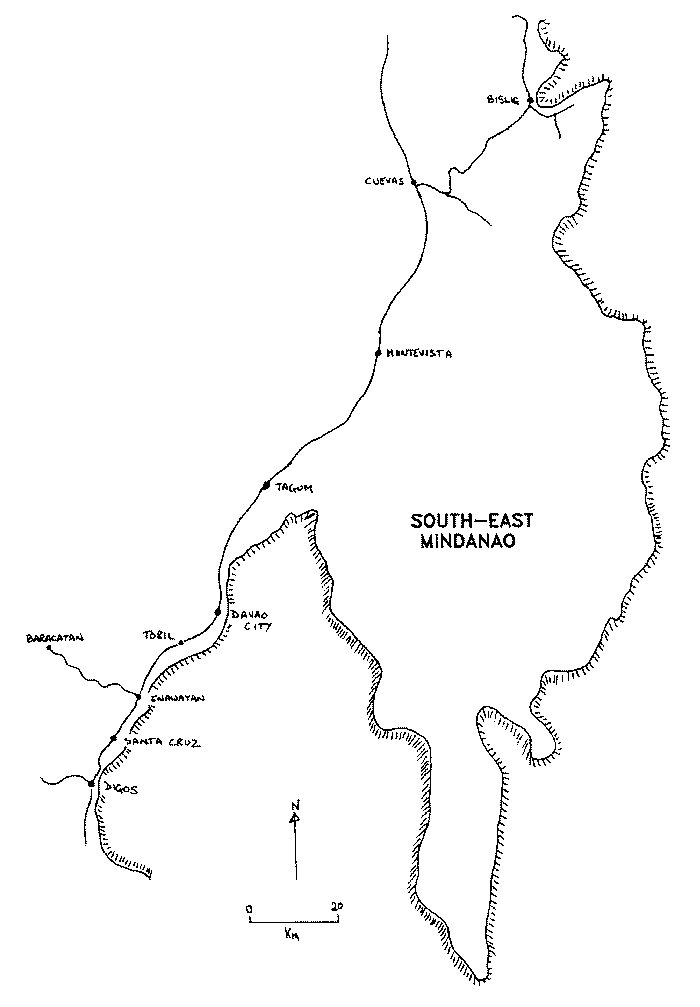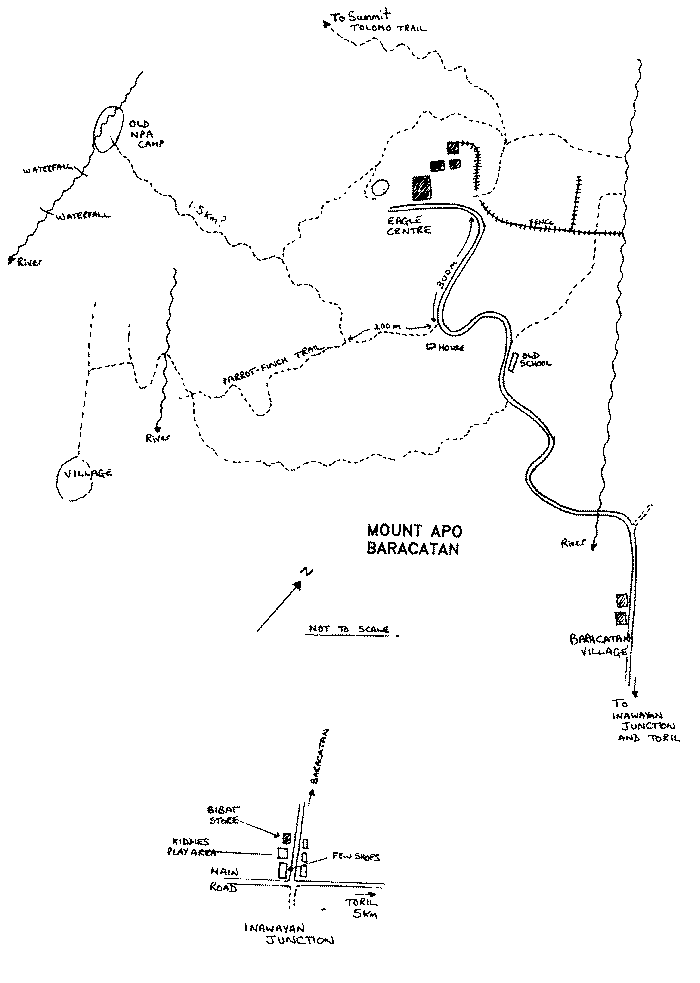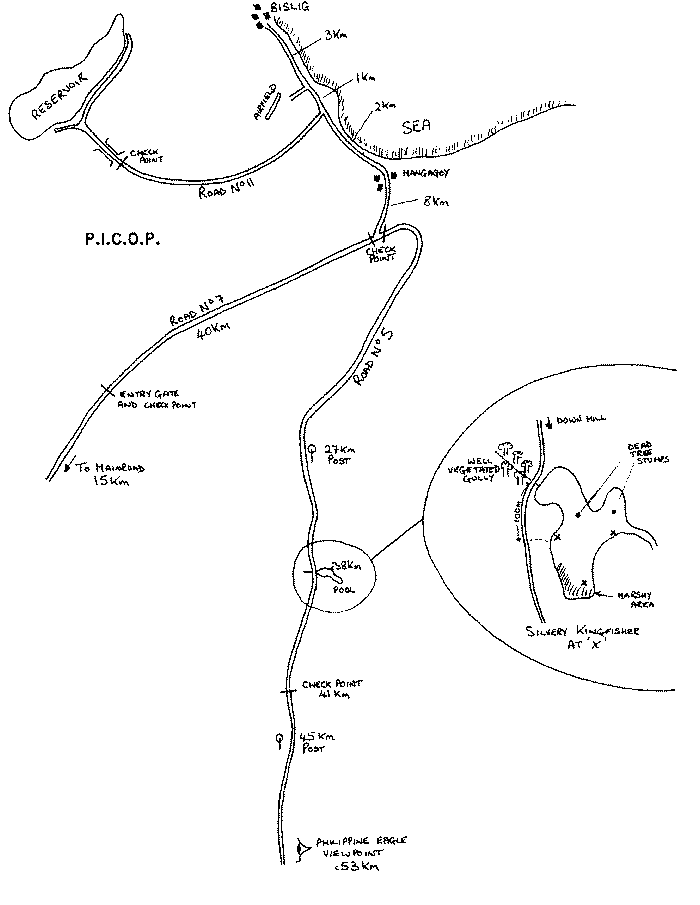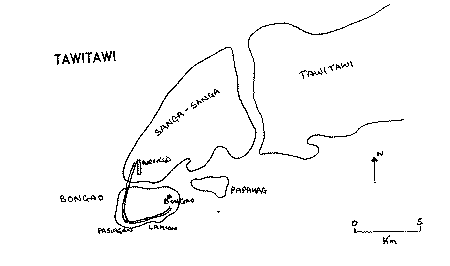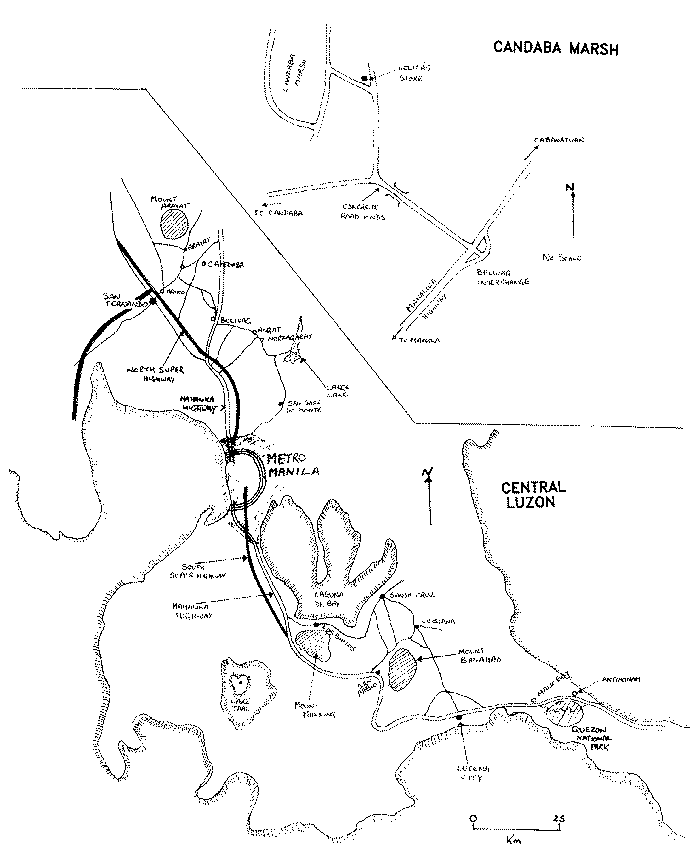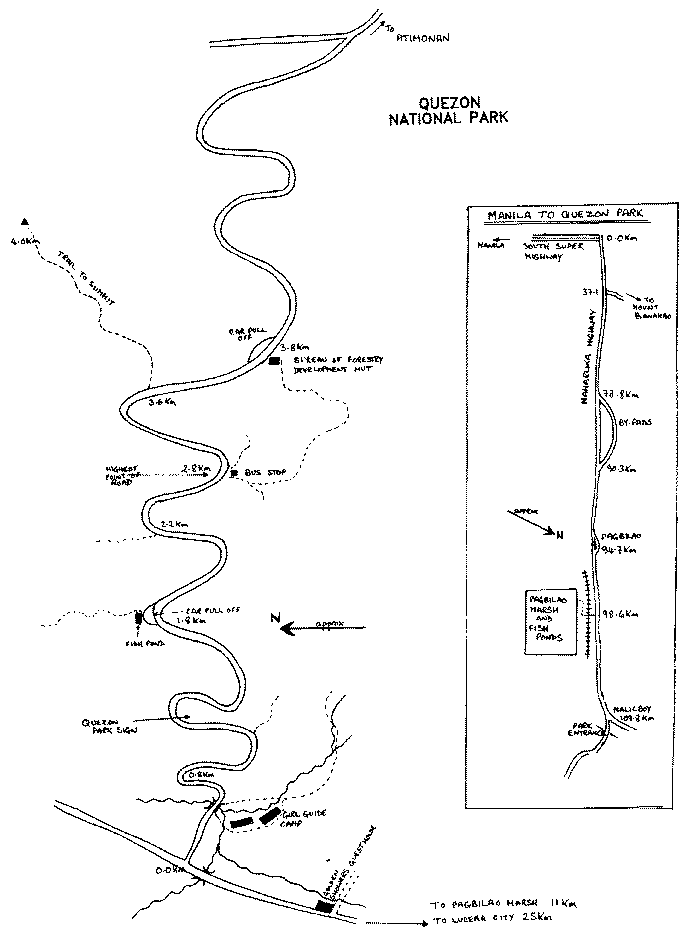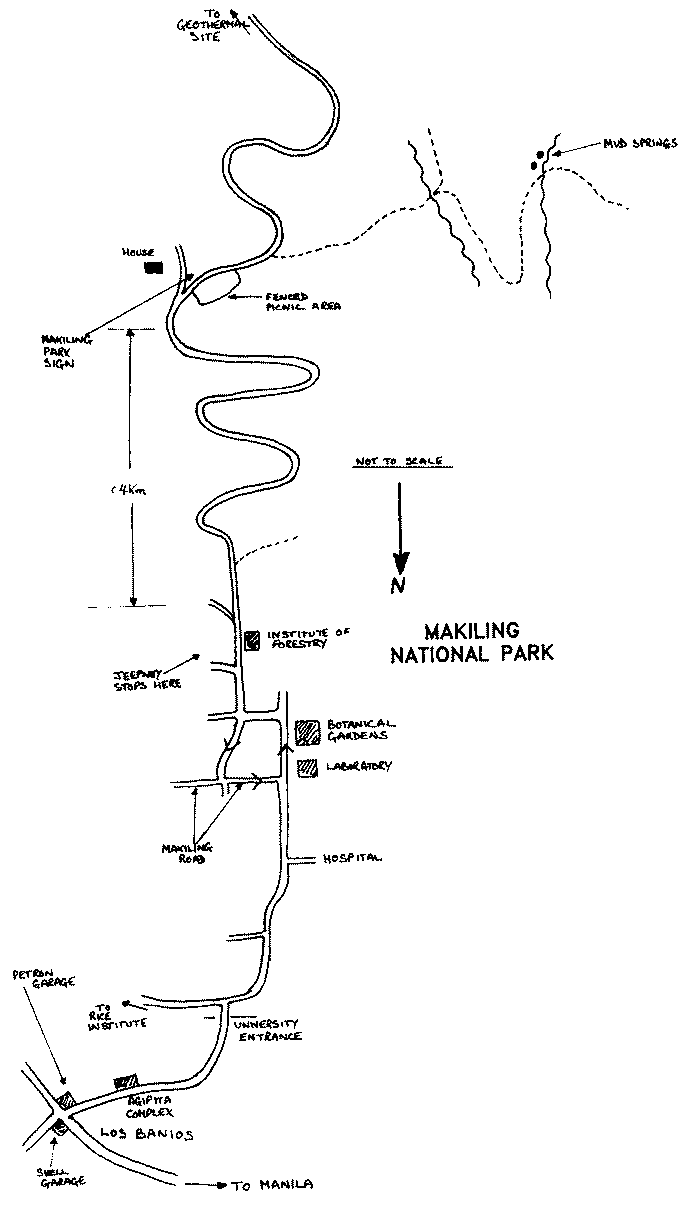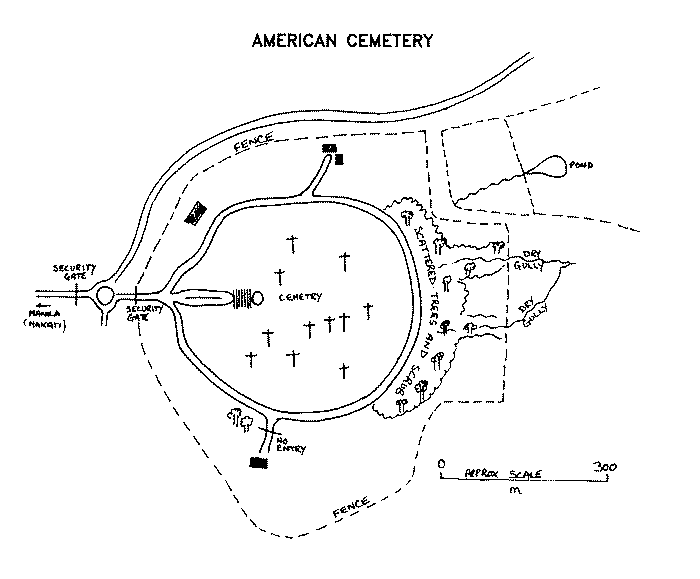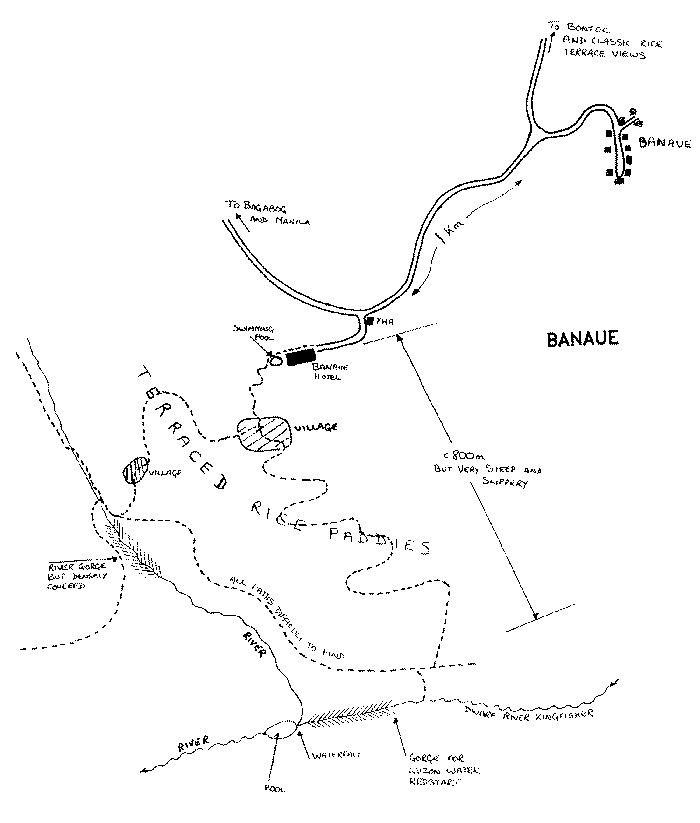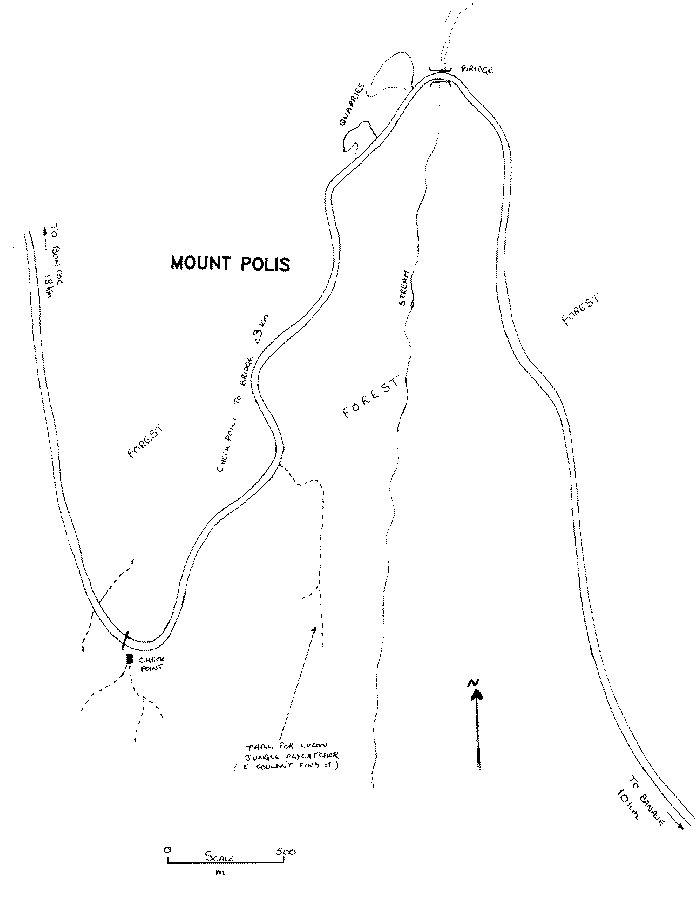Section 1 - Introduction, logistics and general information.
Section 2 - Birding sites (Mindanao and Luzon).
Section 3 - Birding sites (Cebu, Negros, Bohol, Palawan).
Birding Sites
On the site species lists, capitals indicate that the species is endemic. A 'C' denotes that the species was common or fairly commonly observed at the site.
Mindanao
Together with Negros, this island has the strongest NPA presence, making much of the island off-limits. Additionally there are problems in the western parts of the island, an area of moslem majority, where the MNLF (Moro National Liberation Front) wage their own guerrilla war for an autonomous Muslim state. The two best sites on Mindanao, Baracatan and the Paper Industries Corporation of the Philippines (PICOP) concession, both require some advance planning to maximise birding opportunities. Prior to my arrival I made contact with Eddie Cañada, a freelance birding guide, who made the necessary arrangements for both. He also has good contacts with the personnel of the Philippine Eagle captive breeding programme, and usually knows of nesting sites - a good insurance, as you can never be sure on Mindanao which areas are going to be accessible at any one time.
|
|
Mindanao 1. Mount Apo and Baracatan.
This is an excellent area of montane rainforest near Davao. However, Mount Apo National Park, like virtually all Philippine national parks, is under serious threat by illegal logging and hunting activities, and kiligin, a local form of slash and burn farming. The Philippine Eagle Conservation Centre was formerly based at Baracatan, but was relocated to Malagos, Calinan in early 1988. This was done to minimise disturbance by the NPA, to have the availability of electricity, and to ease access difficulties. Road maintenance at Baracatan is the responsibility of the Forestry Department, but because they lack funds this was never done. The road, therefore, will be terrible, although probably passable most of the way. There will probably continue to be some form of accommodation at the centre, since several of the workers there had plans for staying after the project was moved, and they would certainly welcome future visiting birders.
|
|
The area holds many rare and elusive species. To get there, take a jeepney from Davao to Toril, and from there another, the 25 km to Baracatan, the village a few kilometres below the Centre. In Toril you may have to wait a few hours for the jeepney to fill up with enough people going to Baracatan, or alternatively pay for a special. You will need to take all food and camping equipment. To work the area thoroughly at least a week is required. It would not be safe to enter the forest alone, so a guide is essential. Even in 1988, due to the, not surprising, lack of visitors at the Centre, most of the trails had become overgrown, and we had to cut a new trail up toward the summit (the Tolomo trail), which was very time consuming. The Tolomo trail is the area for APO MYNA, APO SUNBIRD and PHILIPPINE MONTANE BULLFINCH. From the Centre it is two hours to a view point (look for a broken-down shelter) from where the PHILIPPINE EAGLE can sometimes be seen. After a further two hours there is a rest area (broken-down seats), beyond which the myna, sunbird and bullfinch can be encountered, although we climbed for 6 hours before finding the later. Baracatan was formerly the most accessible area for seeing the wild PHILIPPINE EAGLE, as they occasionally appeared overhead, or even perched in the trees around the centre, attracted by the calls of the caged birds. However this is now unlikely and local knowledge would be required to locate the eagle. The area around Mount Katanglad, in northern central Mindanao, has many species in common with Mount Apo, and has recently been possible to visit. This new site may become easier to visit.
Species recorded at Baracatan:
Asiatic Honey-Buzzard 2 |
PHILIPPINE FAIRY-BLUEBIRD 1 |
Mindanao 2. PICOP.
PICOP is a large company with, seemingly, free licence to completely destroy the remaining forest in a hugh area covering most of south east Mindanao. The company has its own 'replanting campaign' which replaces the cut down primary forest with hugh plantations of the palacata tree, a fast growing species, the effect of which is akin to cutting down mature oak forest and replacing with eucalyptus. The understorey is also continually cut to maintain maximum growth of the palacata. The whole operation is a conservationist's nightmare. The hardwoods felled are even manufactured into paper. This large area of lowland primary forest has many species of bird not found in Baracatan, and is one of the places to try for the PHILIPPINE EAGLE if not found at Baracatan. Access to road 5 is important for this. Many other difficult species occur, such as WHITE-EARED TAILORBIRD, BLUE-CAPPED KINGFISHER and MINDANAO BLEEDING-HEART. The whole area could easily justify a week's birding.
|
|
To enter the concession you have to have a permit granted by the PICOP office in Davao. My own experience here is probably the most bureaucratic hassle I have ever had birding around the world. Despite having made arrangements in advance, on arrival at the office there was no permit available, and a whole day was wasted just to obtain permission to enter the main gate of the concession. We were told, that once within the concession we would have to seek further permission to gain access to any of the logging roads. From here it took a day and a half of sitting in offices, attending interviews (what did we want to do? did we have a camera? which society did we represent?) and general hassle to eventually obtain a two day permit giving daylight hours access to 60 km of Road No. 5. I had given up any hope of obtaining the permit by this time, and it was only after the personal approval of the deputy director that we were given permission. He even told me that although he would give me the permit, it was against his better judgement, and couldn't understand why any one would come such a distance to 'merely observe birds'. Be aware that the main gate closes at 17h00, with no access thereafter until the next morning. The company guards the whole area jealously and has its own private army. Illegal logging is rife, the NPA is very active in the area, and the recent discovery of gold bearing ore in the area has made the company absolutely paranoid about letting anyone in. Despite the hassle, the area was well worth the visit, especially with the sightings of Philippine Eagle and Silvery Kingfisher we had. As there is no public transport, you need to hire a jeepney and driver, which is best done from Davao. I paid 1,000 Peso/day. Accommodation is available in Mangagoy at the Town and Country Hotel, or alternatively at the small town of Bislig down the road. I found that Road No. 11 could be accessed without a permit, and has disused paddies and some scrub and forest edge, which was well worth a couple of hours in the early morning or late evening. Most of this area was flooded, so it was necessary to wade out to the reed areas beyond the paddies. There is an airfield at Bislig with occasional flights to Cebu.
Species recorded at PICOP:
Yellow Bittern 1 |
Asian Palm-Swift 4 |
Mindanao 3. Tadeco
Described as a small area of wetland between Toril and Bislig, on a private banana plantation, but no details available. Someone at the Eagle Centre might be able to help.
Mindanao 4. Lake Maughan
A large crater-lake surrounded by forest, cultivation and secondary growth. To get to the lake, take a jeepney from Soralla to New Demangeous and find a guide. It's about six hours walk to the lake, and it's necessary to take food and camping equipment, although there is a cave suitable for overnight. Specialities of the area include SHARP-TAILED Cuckooshrike, PLAIN-HEADED RHABDORNIS and WHITE-EARED TAILORBIRD.
Mindanao 5. Polloc
Polloc is an area of mudflats and fish-ponds about 12 km north of Cotabato City. Plenty of jeepneys pass that direction.
Mindanao 6. Caroland Resort
This is an area of parkland between Davao and Toril. To get there, take a jeepney in the direction of Toril and look for a large sign on the right signposted 'Caroland Resort'. There are several ponds in the park which should have PHILIPPINE DUCK.
Sulu 1. Balabek Forest, Tawi Tawi, Sulu Islands
|
The Tawi Tawi group of islands are part of the Sulu island group, which form the most southerly island group in the Philippines. These islands are almost totally unexplored ornithologically, mainly due to reasons of security and difficulty of access. However, for those prepared to try, the Balabek Forest is the easiest place to find the SULU HORNBILL. Balabek Forest is on Sanga-Sanga island near Bairro Lakit-Lakit. Sanga-Sanga can be reached by plane or boat from Zamboanga in western Mindanao. From Bongao, the main town, ask for directions to Barrio Lakit-Lakit, and from there find a guide to take you into the forest. |
Luzon 1. Candaba Marsh.
An area of rice paddies and marshland near Candaba, about 90 km north of Manila. Good early morning and evening for crakes and rails. Other specialities are Speckled Reed-Warbler, Gray's and Middendorff's Warbler and PHILIPPINE DUCK.
|
|
Luzon 2. Mount Quezon
Quezon National Park is a fairly large, accessible area of primary lowland forest situated about 30 km southeast of Lucena City. Mount Quezon, rising to about 500 metres at the centre of the park, has a trail to the summit, and there are several additional trails within the park, though many of these may now be overgrown through lack of use. I was unable to visit in 1988 due to NPA and Philippine Army fighting in the area, though the situation has now improved with the permanent stationing of an army checkpoint in the park. To get there you can drive yourself using the included map. Alternatively, by public transport, take a bus to Lucena City leaving from the B.L.T.B. terminal in Pasay, Manila. Then find a bus or jeepney going to Malicboy, a small village situated at the entrance to the park and which makes the most convenient base. At Malicboy the only place to stay is the 'Golden Shower' guest house, a few hundred metres before the park entrance. Many who have stayed here reckon that it's a dump, but the room I had was clean, and the food good, though somewhat expensive by Philippine guesthouse standards. The major problem was a constant procession of hugh gravel lorries passing throughout the night. After two sleepless nights I was glad to get away. Others have also slept at the girl guide camp just inside the park entrance, but I would doubt if that would be wise at the current time. Take food and water into the park with you as nothing is available.
|
|
Habitat is excellent, but like all forest habitat requires time to get to grips with the species. It would require a week to cover the park adequately. My time there was spent walking along the main road that winds conveniently through the centre of the park, plus the few trails off I could find. The short list of species reflects myself feeling unwell, and the extremely hot weather making the forest virtually birdless for the most part of the day. Birds include SCALE FEATHERED MALCOHA, ROUGH CRESTED MALCOHA, ASHY GROUND-THRUSH, LUZON BLEEDING-HEART, BLACKISH Cuckooshrike, and FLAMING SUNBIRD. Several owl species can be heard along the road at night, and look along the stream behind the 'Golden Showers' for DWARF RIVER KINGFISHER.
Species observed at Quezon National Park:
Chinese Goshawk 1 |
BALICASSIAO 10 |
Luzon 3. Pagbilao Marsh
This marsh and fish ponds is situated on the south side of the Lucena - Malicboy road, about 13 km from Lucena, and is passed en route to Quezon (see Quezon map). To gain access, find the path to the railway, cross over and walk about on the bunds. Birds that have been seen there include: Crakes, Rails, PHILIPPINE DUCK, and Australasian Grass-Owl.
Luzon 4. Makiling
An area of primary rain forest, close to Los Baños, situated directly above the University of the Philippines (UP), and Rice Institute. Local people say the mountain is enchanted and there are numerous stories of strange happenings, especially of people who take the trail to the summit and are never seen again. Many local people will not venture into the park. I was also subsequently told of a section of track known as Magnetic Hill where a car will roll uphill when the handbrake is released. Definitely something to try on a future trip.
|
|
Driving yourself, pay the one peso visitors' entrance fee to gain access to the UP campus, find the Forestry Department, and make your way up the hill into the forest either driving or on foot. By public transport take a bus from the B.L.T.B terminal in Pasay, Manila to Los Baños, and then a jeepney to UP, which may, or may not, go all the way to the Forestry Department. From the Forestry Department the road winds up through forest for about 4 km to a picnic site. It then levels off somewhat and continues to an abandoned, geothermal site. On the right, just after the picnic area, there is a trail to some mud springs. There are many short trails off the road, and the forest seems reasonable for birds all along, though it is somewhat thicker past the picnic site. I saw both SPOTTED WOOD-KINGFISHER and WHITE-EYEBROWED SHAMA very near the Forestry Department. ASHY GROUND-THRUSH also occurs.
As Los Baños is famous for its health spas there is vast range of places to stay and eat. Take food and drink into the park, though sometimes there is a small stall near the picnic area selling cokes. During my last visit a war film was being made in this area, so there was plenty of business. It is probably possible to camp in the picnic area.
Species observed at Makiling:
PHILIPPINE SERPENT-EAGLE 1 |
WATTLED BULBUL 1 |
Luzon 5. American Cemetery, Manila
The cemetery, a memorial to the American soldiers killed in the Philippines during World War II, is inside the Fort Bonifacio area near Makati. Considering its proximity to Manila it holds some good species, including SPOTTED BUTTONQUAIL, Bush Hen, and Barred Rail, which are difficult to find elsewhere. The habitat is open parkland with some areas of scrub. To get there, take a bus to Makati and then a taxi. Identification will be required by security at the entrance, and cars must be left in the car park. The cemetery closes at 17h00, though there are some areas around the perimeter fence that could be worth a look.
|
|
Species observed at American Cemetery:
Japanese Sparrowhawk 1 |
Blue Rock-Thrush 1 |
Luzon 6. Angat Dam
Supposedly, some good secondary forest can be found around the reservoir at Angat, 60 km north of Manila (see Central Luzon map). I have seen no site map, but I don't think the large lake marked on most road maps is the reservoir in question, which is supposed to be near the village of Angat. Local information is required before visiting here.
Luzon 7. Baguio
This can in no way be described as a birding site, although being a favourite Philippine Hill resort it is possible that any visitor could find themselves there, and one could conceivably pass though Baguio to Bontoc and then onto Banaue. Driving from Manila takes about 5 hours, or there are plenty of buses leaving from Quezon City, Manila. Plenty of accommodation in all prices ranges is available.
The area is somewhat reminiscent of Europe with pines trees, and a cool climate, and being at more than 1,200 metres altitude makes a welcome relief from the hot, humid lowlands. There is not much habitat to talk of, though the road past Camp John Hay (American Servicemen's Club open to the public) leads to a fair area of open scrub, and the camp itself is rather splendid parkland. The following species were seen whilst not birding.
PHILIPPINE GREY SWIFTLET C |
White-breasted Wood-Swallow 4 |
Luzon 8. Manila Bay
The area of mud flats directly across Roxas Boulevard, outside the Manila Hyatt Terraces Hotel, is well worth a look. The area is a well known mugging spot after dark, so take care. The mud flats can be viewed directly from the boulevard (your Hotel room if you are staying there), or take the dirt track through the gate into the derelict area where the fishermen live. The morning is best as the area faces due west, with the evening sunset directly in your eyes (something I discovered too late). Through the glare, among many hundreds of waders, the following were identified:
Pacific Golden Plover 6 |
Whiskered Tern 20 |
Luzon 9. Mount Arayat and Mount Banahao
Mount Arayat, a small forested mountain 100 km north of Manila, has never been mentioned as a birding site, but it looked good from the car as I drove past, and would presumably hold lowland forest species. Mount Banahao, 80 km south of Manila, also holds lowland forest species (see Central Luzon map).
Luzon 10. Banaue, Mount Polis and Lagaue
Banaue, a small village in Mountain Province, is world famous for its 2,000 year old rice terraces which were carved from the mountain faces by hand. Birding wise the places of interest are the montane forest on Mount Polis (half way between Banaue and Bontoc), and the river gorges below Banaue village. There is plenty of accommodation in Banaue. Cloud cover could be a problem, and it rained both afternoons I was there. NPA influence is strong, and there were plenty of pro-NPA signs and slogans around the town at the time of my visit. Only a month before, there had been a running battle between government troops and the NPA, who holed-up in the school, were driven out by force. The drive from Manila takes about six hours, or alternatively take the public bus from the Pantranco terminal in Quezon City which takes about eight hours.
|
|
The best view point for the terraces is about 4 km out along the Bontoc Road. This is a dirt road, and although generally passable to two-wheel-drives, after the rain I had the car so badly stuck that mud and water flooded in the doors. Luckily a passing truck had a chain and was able to pull me out, though not without bashing the rear of the car on a protruding outcrop in the process. Banaue being a tourist location it may be a better bet to hire a motor cycle in the town. To get to the pass at Mount Polis, take either a jeepney or the 05h00 Bontoc bus from the Banaue town square.
Mount Polis has many good species, including MARCHE'S FRUIT-DOVE, LUZON MONTANE RACQUET-TAIL, LUZON JUNGLE-FLYCATCHER and , though several days are required to get to grips with most. Destruction by logging and general clearance continues, and was on a scale I had not anticipated. The river gorge below the Banaue Hotel is the place to look for the DWARF RIVER KINGFISHER and LUZON WATER-REDSTART, though the later has now become very hard to find. South of Banaue, the road to Manila passes through Lagaue where it crosses the river. Stop and explore the river gorge, which has DWARF RIVER-KINGFISHER. En route back to Manila, I saw Australasian Grass-Owl in grassland a few kilometres north of San Jose City.
|
|
Species observed at Mount Polis, Banaue and Lagaue:
Cinnamon Least Bittern 1 |
Yellow-vented Bulbul 3 |
Luzon 11. Lake Baao
An extensive area of reed beds 10 km south-east of Pili in southern Luzon, and a good wintering site for Speckled Reed-Warbler. Buses leave from the Pantranco South terminal in Pasay to Naga City. From there take a jeepney to Pili and Baao. You pass the lake at the 464 km marker post. PHILIPPINE DUCK also occurs. Whilst in the general area it may be worth visiting Mayon volcano, which has recently been erupting.
Section 1 - Introduction, logistics and general information.
Section 2 - Birding sites (Mindanao and Luzon).
Section 3 - Birding sites (Cebu, Negros, Bohol, Palawan)

